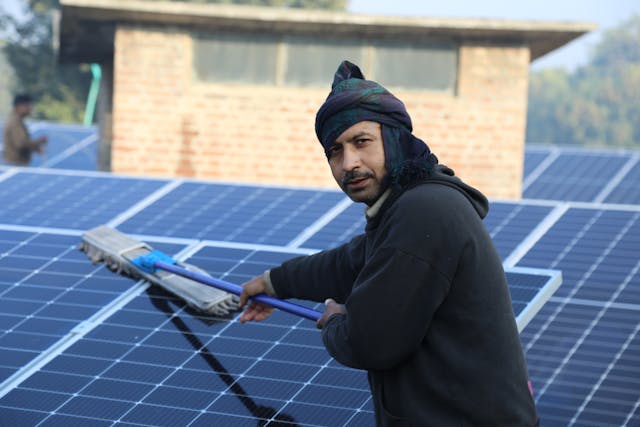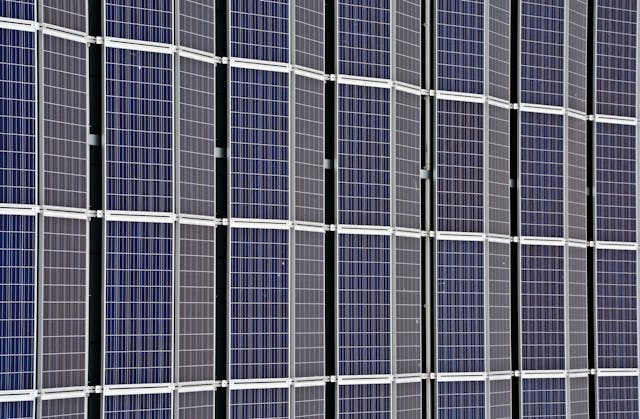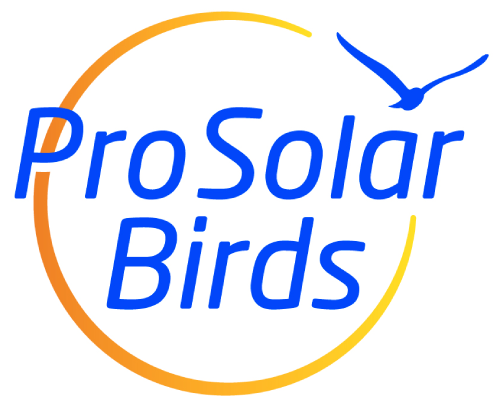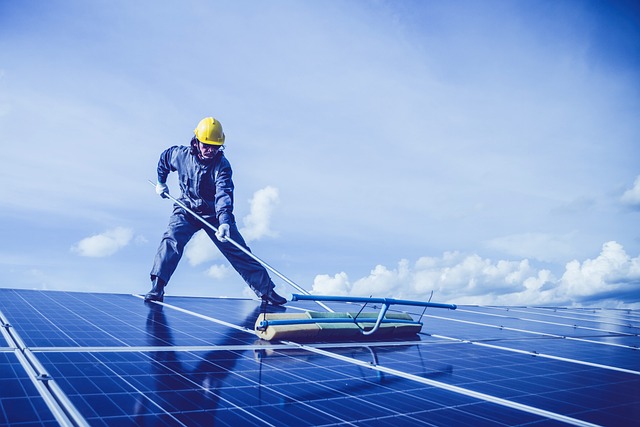Solar panels are hailed for their eco-friendly energy production and cost-saving benefits. But did you know that maintaining clean solar panels is essential for maximizing their efficiency?
Over time, dirt, dust, bird droppings, and other debris can accumulate on the surface of solar panels, reducing their ability to generate electricity.
In this guide, we’ll explore the importance of cleaning solar panels and provide you with a comprehensive step-by-step process to keep your panels shining bright.
Table of contents
- Understanding Solar Panel Cleaning
- Preparing for Cleaning
- Step-by-Step Cleaning Process
- Maintaining Long-Term Efficiency
- FAQ’s
Understanding Solar Panel Cleaning
Solar panels are an integral part of renewable energy systems, converting sunlight into electricity with remarkable efficiency. However, to maintain peak performance, it’s crucial to understand the nuances of cleaning these panels.
Factors Affecting Cleanliness
Several factors influence the cleanliness of solar panels, impacting their efficiency and overall output:
- Location: Panels situated in dusty or polluted environments require more frequent cleaning. Areas with heavy bird activity may experience more significant buildup from droppings.
- Weather Conditions: Rain can naturally rinse panels, but frequent cloud cover or high humidity may lead to residue buildup over time.
- Surrounding Environment: Proximity to trees, bushes, or buildings can result in leaves, sap, or debris accumulating on panels, blocking sunlight.
Types of Debris
Understanding the types of debris that can accumulate on solar panels helps tailor cleaning methods:
- Dust: Fine particles settle on panels over time, reducing sunlight absorption and efficiency.
- Bird Droppings: Besides being unsightly, bird droppings can block sunlight and corrode panel surfaces if not promptly removed.
- Tree Sap and Pollen: Sticky substances like sap and pollen can adhere to panels, hindering performance.
Frequency of Cleaning
The frequency of cleaning depends on various factors, including the panel’s location and environmental conditions. As a general guideline, experts recommend cleaning solar panels at least twice a year. However, panels in particularly dusty or bird-prone areas may require more frequent attention.
Preparing for Cleaning
Before diving into the task of cleaning your solar panels, it’s crucial to make adequate preparations to ensure both your safety and the effectiveness of the cleaning process.
1. Safety Precautions
Cleaning solar panels involves working at heights and handling water and cleaning solutions, so prioritizing safety is paramount. Here are some essential safety precautions to follow:
- Turn Off the Solar Panel System: Before beginning the cleaning process, switch off the solar panel system to eliminate the risk of electric shock. This step is vital for your safety and the protection of the solar panels.
- Wear Appropriate Safety Gear: When working with cleaning solutions and water, wear protective gear such as gloves and safety goggles to shield your hands and eyes from potential hazards.

2. Gather Necessary Equipment and Materials
Having the right tools and cleaning materials on hand will streamline the cleaning process and ensure thorough cleaning without causing damage to the solar panels. Here’s what you’ll need:
- Soft Brush or Sponge: Choose a gentle, non-abrasive brush or sponge to remove dirt and debris from the surface of the solar panels. Avoid using abrasive materials that could scratch or damage the panels.
- Non-Abrasive Detergent: Select a mild, non-abrasive detergent that is safe for use on solar panels. Avoid harsh chemicals or abrasive cleaners that could corrode or degrade the panel’s surface.
- Hose or Bucket of Water: You’ll need a source of clean water for rinsing the panels after cleaning. A garden hose with a gentle spray nozzle or a bucket of water will suffice.
- Squeegee or Soft Cloth: Use a squeegee or soft cloth to dry the panels after rinsing. Opt for a non-abrasive material to prevent scratching the panel’s surface.
- Extension Pole: If your solar panels are installed in hard-to-reach areas, such as on a rooftop, an extension pole can help you reach them safely and effectively.
3. Plan Your Approach
Before you start cleaning, assess the layout of your solar panel system and plan your cleaning approach. Determine the best route for accessing the panels safely and efficiently, considering factors such as obstacles, terrain, and any potential hazards.
Step-by-Step Cleaning Process
Now that you’ve taken the necessary safety precautions and gathered your cleaning supplies, it’s time to embark on the cleaning process. Follow these step-by-step instructions to effectively clean your solar panels:
1. Assess the Condition of the Panels
Before you begin cleaning, take a moment to inspect the condition of your solar panels. Note any areas with visible dirt, debris, or staining that may require extra attention during the cleaning process.
2. Dust Off Loose Debris
Using a soft brush or sponge, gently remove any loose debris from the surface of the solar panels. Start at the top of the panels and work your way down, using light, sweeping motions to dislodge dust and dirt. Be careful not to apply too much pressure, as this could scratch or damage the panels.
3. Prepare the Cleaning Solution
In a bucket, mix a mild, non-abrasive detergent with water to create a cleaning solution. Avoid using harsh chemicals or abrasive cleaners that could damage the surface of the solar panels. A few drops of dish soap or a specialized solar panel cleaning solution diluted in water should suffice.
4. Wash the Panels
Dip your soft brush or sponge into the cleaning solution and gently scrub the surface of the solar panels. Work in small sections, starting from the top and moving downwards, to ensure thorough coverage. Pay extra attention to areas with stubborn dirt or staining, applying gentle pressure to loosen and remove the debris.
5. Rinse with Clean Water
Once you’ve scrubbed the panels, rinse them thoroughly with clean water to remove any remaining detergent residue. Use a garden hose with a gentle spray nozzle or a bucket of water to rinse the panels, ensuring that all soap suds are completely washed away.
6. Dry the Panels
To prevent water spots and streaks from forming on the surface of the panels, use a squeegee or a soft, lint-free cloth to dry them. Start at the top of the panels and work your way down, using smooth, overlapping strokes to remove excess water. Be gentle to avoid scratching the panels, and ensure that they are completely dry before turning the solar panel system back on.
7. Perform a Final Inspection
Once the panels are dry, take a final moment to inspect them for any remaining dirt, debris, or streaks. Touch up any areas that may require additional cleaning, and make sure that the panels are free from obstructions that could block sunlight and reduce their efficiency.
Special Considerations
Depending on your location and environmental conditions, you may encounter unique challenges when cleaning solar panels. For example, panels in areas with high bird activity may require more frequent cleaning to remove bird droppings.
Stubborn stains or residues may require additional cleaning techniques, such as using vinegar or specialized cleaning solutions. Be cautious when handling delicate solar panel components, and consider hiring professional cleaning services for larger or more complex installations.

Maintaining Long-Term Efficiency
Cleaning your solar panels is just one aspect of ensuring optimal performance and longevity. To truly maximize the efficiency of your solar panel system over the long term, it’s essential to implement a comprehensive maintenance plan. Here’s how you can maintain long-term efficiency:
1. Regular Inspections
Schedule routine inspections of your solar panel system to check for any signs of damage, dirt buildup, or other issues that may affect performance. Inspect the panels, mounting hardware, wiring, and connections for any visible damage or wear and tear. Addressing problems early can prevent them from escalating and ensure continued efficiency.
2. Monitor Energy Production
Keep track of your solar panel system’s energy production to detect any changes or anomalies that may indicate performance issues. Compare current energy output with historical data to identify trends and potential problems. Monitoring software or systems provided by your solar panel installer can help you track energy production and detect any deviations from expected performance.
3. Implement Preventive Measures
Take proactive steps to prevent dirt buildup, shading, and other factors that can reduce the efficiency of your solar panel system:
- Bird Deterrents: Install bird deterrents such as spikes, nets, or decoys to discourage birds from perching or nesting on or near your solar panels. Bird droppings can block sunlight and decrease energy production.
- Shade Management: Trim back overhanging branches or vegetation that may cast shadows on your solar panels, especially during peak sunlight hours. Shading can significantly reduce energy output, so it’s essential to minimize shading as much as possible.
- Rainwater Collection Systems: Consider installing rainwater collection systems to capture and reuse rainwater for cleaning your solar panels. Rainwater is naturally clean and can help rinse away dust and debris without the need for additional cleaning solutions.
4. Professional Maintenance
While regular cleaning and maintenance can be performed by homeowners, it’s also beneficial to schedule professional maintenance checks periodically. Professional solar panel technicians can perform comprehensive inspections, cleaning, and maintenance to ensure optimal performance and address any issues that may arise.
FAQ’s
1. How often should I clean my solar panels?
The frequency of cleaning depends on various factors such as your location, weather conditions, and the surrounding environment. As a general guideline, it’s recommended to clean your solar panels at least twice a year. However, panels in dusty or bird-prone areas may require more frequent cleaning, while those in cleaner environments may need less frequent maintenance.
2. Can I clean my solar panels myself, or should I hire a professional?
While cleaning solar panels can typically be done by homeowners, it’s essential to prioritize safety and use the proper cleaning techniques and materials. If you’re comfortable working at heights and following safety precautions, you can clean your solar panels yourself. However, if your panels are installed in hard-to-reach areas or if you’re unsure about the proper cleaning methods, it may be best to hire a professional solar panel cleaning service.
3. Will cleaning my solar panels increase their efficiency?
Yes, cleaning your solar panels can improve their efficiency by removing dirt, dust, and debris that may block sunlight and reduce energy production. Studies have shown that regularly cleaning solar panels can lead to a significant increase in energy output, sometimes up to 20% or more. By keeping your solar panels clean and well-maintained, you can ensure that they operate at peak efficiency and continue to generate clean, renewable energy for your home or business.

